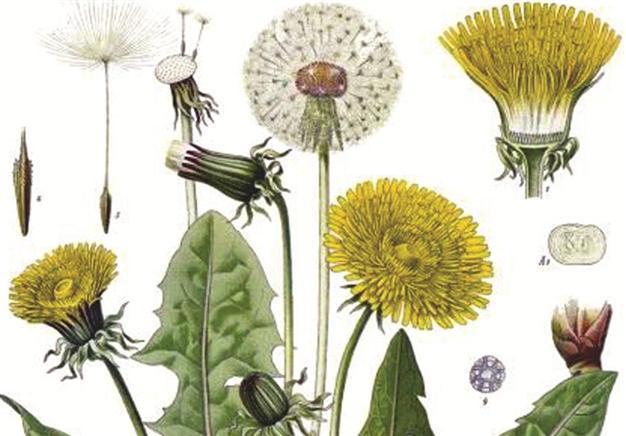Lion’s Teeth to cure effects of Lion’s Milk
Aylin Öney TAN - aylin.tan@hdn.com.tr

Dandelions are everywhere now! Your gardener may hate them, but they’re a delight in the kitchen.
Dandelion flowers are definitely the marker of spring. The dandelion, or “Taraxacum officinale,” must be one of the most familiar plants worldwide. The clusters of dark green leaves may go unnoticed at first, but within a few days the tiny caper like bulbs will bloom into the familiar sunny yellow flowers springing up in almost every corner. Anyone can identify a dandelion from other plants and flowers, at least when they bloom into their iconic yellow flowers, soon to turn into the joyful puffballs, a favorite of all kids. That is exactly the time spring has officially begun.
The name “dandelion” comes from teeth-like edged leaves of the plant. Dent-de-Lion in French, meaning Lion’s teeth, was eventually converted to the English dandelion. Also called Lion’s teeth in German, Löwenzahn, and in Italian, Dente di Leone, the plant is entirely edible, all its leaves, stems, flowers, and roots. The root is dried and roasted as a caffeine-free coffee substitute, having a bitter coffee-like taste. The leaves are also very bitter, but the bitterness can be extracted by briefly boiling them, or masking the bitterness with other tastes such as vinegar, oil, fat, or something sweet. The French and Italians make a salad of dandelions with crisp fried bacon, lardon or pancetta, poured hot over the leaves, wilting them slightly, then tossed with some good red wine vinegar. A handful of raisins and toasted pine nuts can be thrown in to contrast the bitterness. Some prefer to boil away the bitterness, but very young tender leaves grown in the shade are not too bitter and can be nibbled raw. The flowers are used to make wine-like drinks or honey-like jams or syrups. A local French specialty cramaillotte is a bitter-sweet delight of oranges, lemons and sunny dandelion flowers, cooked into a perfect jam.
Unfortunately, very few seem to think about dandelions as edible. But I’m sure everyone would be out in the countryside, foraging wildly, if only they knew about the health benefits of the humble dandelion. Dandelion also has one more name not found in its English language usage, being called Pissenlit in French, and Piscialetto in Italian. Meaning “wetting the bed,” this name surely refers to its properties as a strong diuretic agent. Indeed, it is a wonderful liver and kidney tonic, very good for restoring and detoxifying a liver weary of alcohol. Exceptionally rich in vitamins A and C, and minerals like iron, calcium and potassium, the list of benefits of dandelions is endless. It is good for diabetes, improves bone health, helps maintain alkaline levels in the body, stimulates digestion, relieves constipation, and even prevents and treats cancer. So potent as a liver aid and a detox agent, the dandelion can be as powerful as lion’s teeth as a cure for “Lion’s milk,” namely the Turkish national spirit “Rakı.”
Foraging is a new trend. Wild greens have always been an invaluable source of nutrients for villagers since the age of hunters and gatherers, but now it’s becoming a part of the high restaurant scene as well. Top Danish restaurant Noma has been one of the first to rediscover foraging, and now the trend has spread all over the world. This must be one of the easiest high cuisine fashions to follow, and the only one that costs nothing, not even a penny. Now go out and pick some dandelions for your next bite! You’ll be rewarded.
Recipe of the Week: Dandelion salad is a way to enjoy the health benefits of the miraculous plant. If the young leaves are chopped raw into yoghurt or sautéed with onions and mixed with garlic yoghurt, it will be a calcium bomb. It not only contains lots of the stuff, but will allow the calcium in the yoghurt to be absorbed more easily by the body. Just keep in mind that a serving of dandelion leaves contains the same amount of calcium as half a cup of milk.
The flowers would make the most astonishing nibble to go along with your happy hour drink. Make a beer batter with 1 cup flour and 1 cup beer, seasoned with ½ teaspoon salt. You may also add hot paprika or other spices or herbs of choice like fresh dill. Wash the dandelion flowers and pat them dry. Dip each flower in batter and deep fry in extra virgin olive oil until crisp and golden. Enjoy!
Bite of the week
Fork of the week
Make your dandelion wine. Or, good old Lion’s milk rakı may go perfectly with the bitterness of your Lion’s teeth. Tekirdağ-Trakya Serisi made in the province of Thrace is a good, fresh-tasting spring choice.
Cork of the week
Cramaillotte, or Confiture de Pissenlits, is unfortunately not available in Turkey, so I decided to provide you with another recipe as a choice of fork for the week. Pick 400 dandelion flowers (good exercise!), and boil for half an hour in 1.5 liter water with two oranges and two lemons, chopped roughly, peel and flesh all together. Filter the juice though a sieve and mix with 1 kg of sugar and 1 packet of dry pectin. Bring back to boil until it gels and pour in jars.
 Dandelions are everywhere now! Your gardener may hate them, but they’re a delight in the kitchen.
Dandelions are everywhere now! Your gardener may hate them, but they’re a delight in the kitchen.